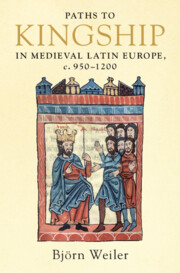Book contents
- Paths to Kingship in Medieval Latin Europe, c. 950–1200
- Paths to Kingship in Medieval Latin Europe, c. 950–1200
- Copyright page
- Contents
- Maps
- Acknowledgements
- Abbreviations
- Timeline
- Introduction
- Part I Foundations
- Part II Creating Kingship
- Part III Succession
- Part IV Election
- Part V Inauguration
- 9 Enthroning the King
- 10 Beyond Enthronement
- Conclusion
- Select Reading
- Index
Conclusion
from Part V - Inauguration
Published online by Cambridge University Press: 24 September 2021
- Paths to Kingship in Medieval Latin Europe, c. 950–1200
- Paths to Kingship in Medieval Latin Europe, c. 950–1200
- Copyright page
- Contents
- Maps
- Acknowledgements
- Abbreviations
- Timeline
- Introduction
- Part I Foundations
- Part II Creating Kingship
- Part III Succession
- Part IV Election
- Part V Inauguration
- 9 Enthroning the King
- 10 Beyond Enthronement
- Conclusion
- Select Reading
- Index
Summary
The conclusion draws together key themes. In particular, it deals with the question of the people and with change over time. On the one hand, the ‘people’ below the ranks of elite churchmen and aristocrats were excluded from the king-making process. On the other hand, their welfare was central to the moral framework of kingship. How could this tension be reconciled? How could it be utilised and exploited by political actors? Furthermore, accounts of king-making projected an ideal of timelessness: rulers merely continued a long line of kings, for example, and were but the most recent in a sequence of leaders of a community. Public acts like designation, election or inauguration hearkened back to an ideal status quo ante rooted in the Bible. What did this mean for historical change? How did contemporary observers deal with issues of a ruler’s life cycle, or with the span of individual experience? How could change be incorporated into an ideal of timelessness?
- Type
- Chapter
- Information
- Paths to Kingship in Medieval Latin Europe, c. 950–1200 , pp. 399 - 411Publisher: Cambridge University PressPrint publication year: 2021

